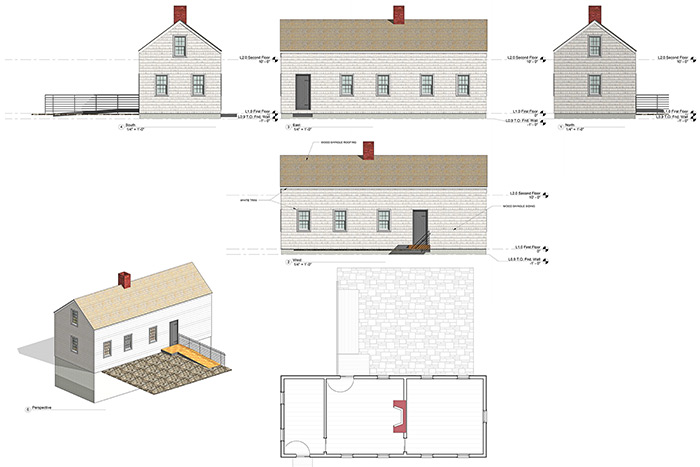Slave or Servant? The Story of Pyrrhus Concer

What is known is that Pyrrhus Concer was born to a mother who was a slave in 1814 in Southampton, and lived in that town for his whole life, except when he became a mate aboard a whaling ship out of Sag Harbor, traveling around to see the world. And we know for the last half of his life, he ran a water taxi—a small sailboat—that crossed Lake Awagam from Monument Square to the beach at the south end, charging 10 cents a ride. He died at age 83.
It is also known that as a five-year-old, he was sold by Captain Nathan Cooper of Southampton to Elias Pelletreau II (of the clock-making family) for $25. We also know that he got married to a Southampton girl, Rachael Williams. The two are buried together in the North End Cemetery here.
Ground is breaking soon to rebuild Pyrrhus Concer’s modest home on the site where he lived on Pond Lane. Many of the original beams and flooring will be used. It will be open as a museum about Concer’s life and the slave era in which he lived. It’s probably the first of its kind on Long Island.
Slavery was declared illegal in New York State in 1827. So at 13 years old, he was not a slave anymore, at least in theory. In fact, he remained indentured after that ruling for eight years at the Pelletreau family farm, at which time Elias Pelletreau declared him “free.” And then he continued to work there for Mr. Pelletreau for five years after that.
Indeed, there is a fair argument that Concer was never a slave, even at the time. As the son of a slave, born after 1799 in the State of New York, he would officially have been labeled an “indentured servant.” But in his day-to-day life as a young lad, it would have been no different for him than if he had been a slave.
It it’s fascinating to look into how “slave” and “indentured servant” got to refer to virtually the same thing for a generation.
On January 1, 1799, New York State passed a law declaring that slavery in New York would gradually be phased out during the upcoming decades. At that time, New York City was a manufacturing and financial hub for the fledgling nation. Though slavery was rampant throughout the South on cotton and other farm plantations, it was looked down upon in the north—although many people in the north did have slaves.
In the late 1790s, at a time when it was still unclear whether the 13 colonies would become a sturdy country with strong powerful national laws, every state was still powerful enough to pass its own laws about slavery.
In New York beginning in 1793, a law to phase out slavery was brought up three times and tabled each time, mostly by the votes of Dutch legislators, who were the biggest slaveholding group here. John Jay, who became governor of New York in 1795, was damned in newspapers, saying he wanted to “rob every Dutchman of the property he possesses most dear to his heart, his slaves.” In 1799, the law phasing out slavery finally passed. Erastus Root, a state senator, wrote “(The Dutch) raved and swore by ‘dunder and Blixen’ that we were robbing them of their property. We told them that they had none and could hold none in human flesh, while yet alive, and we passed the law.”
However, though pass it they did, they had to add many amendments that would soften the blow to the slaveholders.
Current slaves would remain slaves for life. The children born to slave women between July 4, 1799 and July 4, 1827 (Concer was born in 1814), were declared born free, PROVIDED (my caps) “(that) nevertheless such child shall be the servant of the legal proprietor of his or her mother, until such servant, if a male, shall arrive at the age of twenty eight years, and if a female at the age of twenty-five years…in the same manner as if such child had been bound to service by the Overseers of the Poor.”
The Overseers of the Poor provided food and shelter to the poor. An allowance was given. But you worked free for the Overseers in exchange.
In other words, slaveholders now charged room and board and the “former” slaves did the work to make it back. The only difference between slaves and these new slaves was that the ones born after 1799 knew they would someday be freed.
In the early 1800s, after the transition law was initially passed, the length of time required for the young person’s indenture was gradually reduced. By the time Concer was born, the indenture was to age 18.
Since I wrote about Pyrrhus Concer last week, I have come upon more information about his life. He went off on the whaling ship Manhattan out of Sag Harbor in 1843, eight years after being “freed” by Mr. Pelletreau. He was the pilot. The Captain was Mercator Cooper, the son of Nate Cooper, Concer’s original owner. Landing on one of the Bonin Islands to search for turtles for food, the whalers came across 11 Japanese men in rags who had been shipwrecked there three months before.
The Japanese were originally afraid of the Americans and ran off into the woods, but the Americans followed and the Japanese, after receiving assurances from the Americans, allowed themselves to be rescued and brought back to Japan. The Manhattan was only allowed to anchor in Tokyo harbor. None aboard were allowed ashore. That was because foreigners were not permitted to come to Japan back then. The shipwrecked Japanese sailors, however, were sent ashore as “messengers to the Emperor” to explain their circumstances while Japanese soldiers remained aboard the Manhattan to see that the Americans did not disembark. The soldiers were fascinated with the color of Concer’s skin, Concer later said, and rubbed him to see if the color would come off. It didn’t.
Upon returning to Southampton, Concer bought a barn on Pond Lane, built a fireplace inside for heat and cooking, built an outhouse out back and made it his home. In 1847, he married Rachael Williams and she bore him two sons, both of whom died before their parents did. Concer went off on a whaleboat again out of Sag Harbor, this time winding up in California for the gold rush in 1849, but after a time there he returned home to Southampton. He bought property here and became well-to-do in his later years. He went to court to defend his ownership of some property after it was challenged, and won. When he died, his estate was distributed to charitable organizations including the First Presbyterian Church of Southampton, of which he and Rachael were upstanding members.
Here are some entries in the New York study done about slavery in that era.
“When Judge Abraham Woodhull of Brookhaven registered the birth of David to his slave woman on August 8, 1805, he certified that he ‘shall Not abandon said Child but shall keep him as his property until he shall arrive to the age of 28 years.’
“Black children who fulfilled their service obligations in white households between 1799 and 1848 show up in church records as well as in census enumerations. Due to high childhoold mortality rates, some of them never lived long enough to see freedom…In December 1834 a ‘colored child at Mr. Van Scoy’s’ died in the town of East Hampton.”
“On April 5, 1831, the executor of the estate of Timothy Miller manumitted [freed] ‘a certain slave’ Jeremiah. Jeremiah had been born in Timothy Miller’s house to a slave woman on December 1, 1809, and therefore owed service until 1837 when he would reach the age of twenty-eight. Instead of selling the seven remaining years of his service, the executor chose to free him from all obligation early at age twenty-one.”
That would have been four years after slavery was declared illegal in New York. Pyrrus Concer would have been 17 and still with Pelletreau.



